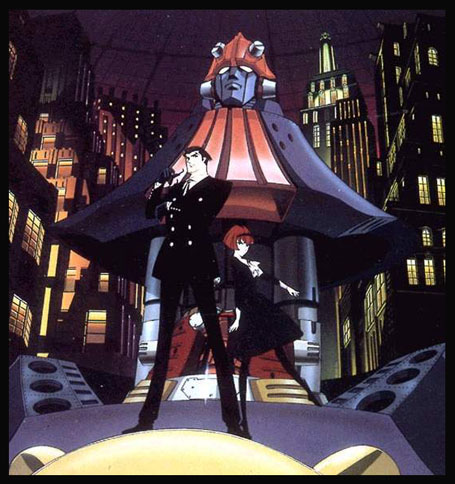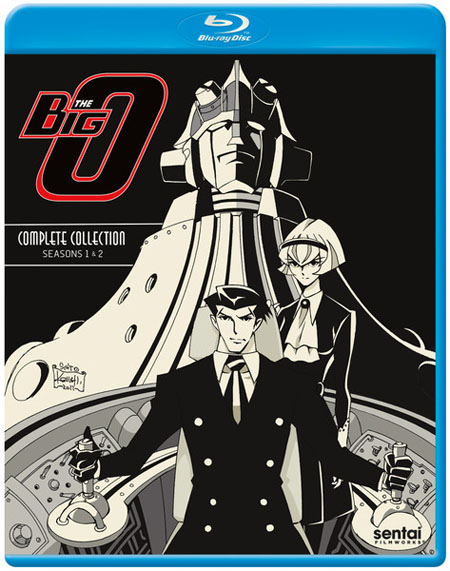
The simplified, Art Deco-influenced designs in the mecha adventure The Big O give the series a look that’s closer to Warner Bros.’ old animated Batman than Gundam.
Originally concieved as 26-episode adventure, The Big O premiered in October, 1999, in Japan, but was cancelled after only 13 episodes due to poor ratings. The English language version began on Cartoon Network in 2001, and its international success led to the creation of the 13 remaining episodes, which were co-produced by Cartoon Network.
The Big O is set in Gotham-esque Paradigm City; 40 years ago, the inhabitants lost their memories in a bizarre occurrence referred to as “the Event.” Since then, people have scrabbled out a living in the half-ruined metropolis. Dashing Roger Smith (voice by David Lucas in the first 13 episodeds; Stephen Jay Blum in the second 13), who looks a bit like a young Pierce Bronson, is officially a Negociator who handles difficult situations, but he’s really a covert superhero.
Obviously modelled on Bruce Wayne, Roger is fabulously wealthy. He lives in a sumptuous penthouse; his car and wrist watch are loaded with deadly gadgets that rival James Bond’s Aston Martin. He’s assisted in his endeavors by his butler, Norman Burg (Akan Oppenheimer), and R. Dorothy Wayneright (Lia Sargent), a life-like automaton he rescues in the first episode.She becomes a sort of cyber-Gril Friday. But when the going gets tough, Smith summons The Big O, his giant “Megadeus” mecha to slug it out with rival robots and other threats as a sort of machina ex dei.
Unfortunately, the stories lack the depth of plot and characterization needed to support the stylish graphics. Many of the scripts were written by Konaka Chiaki, who was also a writer on Serial Experiments Lain, and the storytelling is similarly opaque and fragmented. Too many of the episodes follow a single pattern: Roger oversteps his mandate to capture a villain; when his actions land him him in trouble, he summons the title character and beats the motherboard out of the bad guy. Mission accomplished, Roger returns to his penthouse.
But the viewer never finds out who’s dispatching the frogmen Roger battles or the identity of the mysterious woman known as “Angel” in Episode #7, “The Call From the Past.” Smith’s former boss, Major Datsun, is haunted by a spectral image that may be a lost memory or an illusion in Episode #10, “Winter Night Phantom.” But the filmmakers add images of Jacqueline Kennedy and John-John at JFK’s funeral to the visuals in a singular lapse of taste.

The first season ended in mid-story, with the fate of the characters unresolved. The belated second season brought back all the main characters and the stylish designs. Roger’s nightmares/flashbacks, collages of robot attacks, burning cities, etc. led to a resolution of sorts, but once again, visual flash takes the place of clear storytelling.
In some sequences, the cool, grayed-down palate, saxophone riffs and tough guy dialogue suggest the filmmakers are trying capture the film noir tone that made Cowboy Bebop a hit. But the stories lack the strong plot and gritty characters needed to support the stylish graphics. Spike Spiegel projected the intensity of a wounded lion; Smith feels superficial. Director Kazuyoshi Katayama simply lacks the visual pancahe of Shinichiro Watanabe, one of the most interesting directors working in anime.
Like Warner Bros.’ Batman, The Big O looks better in stills than it does in motion.

The Big O
Sentai Filmworks: $79.98 4 discs, Blu-ray & DVD
- Charles Solomon’s Animation Year End Review 2023 - December 28, 2023
- INTERVIEW: Makoto Shinkai on “Suzume” - November 27, 2023
- Interesting Portrayals of Gay Men in Manga/Anime - June 12, 2023


 June 28th, 2017
June 28th, 2017  Charles Solomon
Charles Solomon  Posted in
Posted in  Tags:
Tags: 






